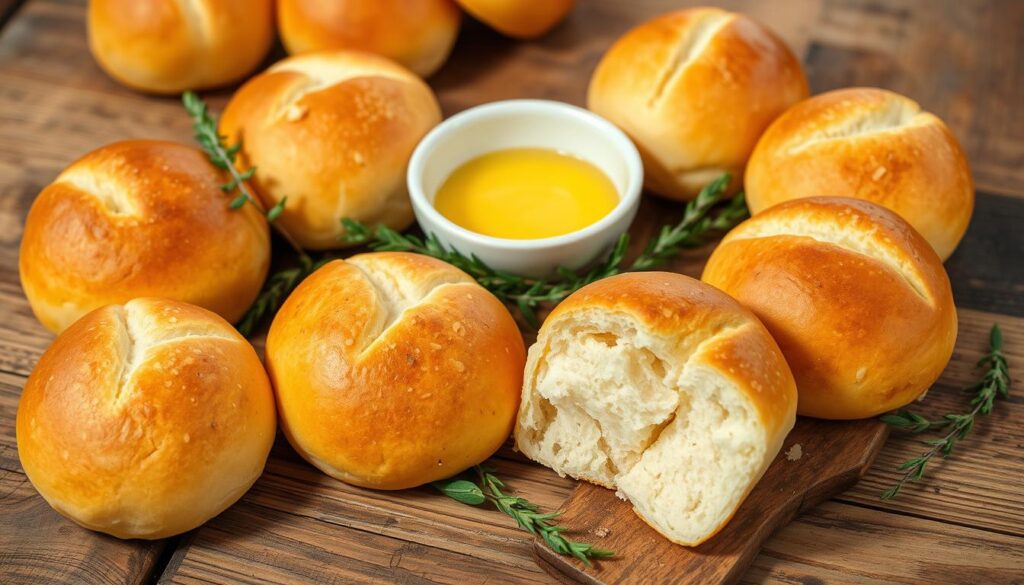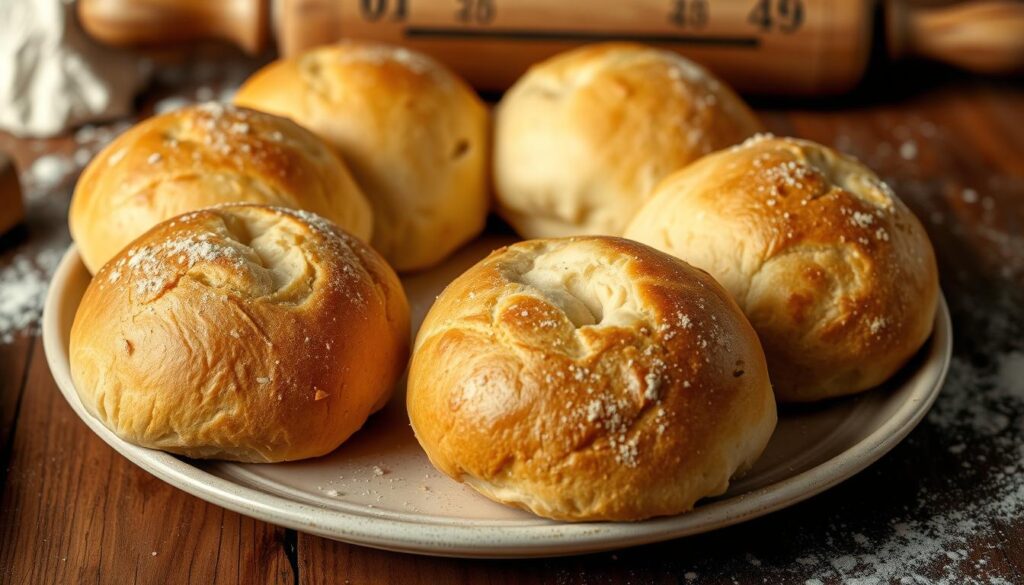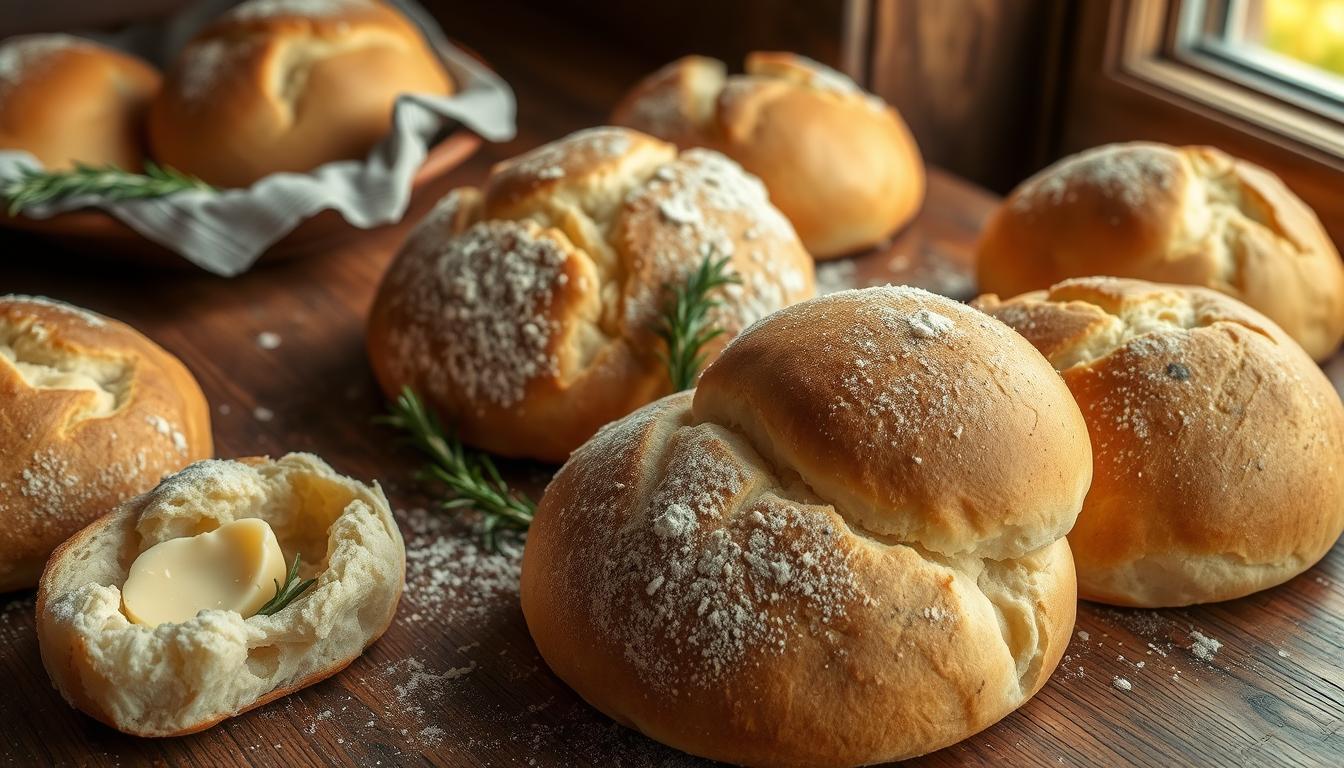Table of Contents
The smell of fresh sourdough dinner rolls is like a magnet, pulling you into the kitchen. Whether you’re a pro or just starting, making these soft, tangy rolls is a joy. In this guide, we’ll explore how to make sourdough dinner rolls that will wow everyone.
Whether you’re new or experienced, you’ll learn key sourdough skills. You’ll discover how to work with starters, mix, knead, proof, and shape the dough. With these tips, you’ll become a pro at making dinner rolls sourdough, sourdough dinner rolls, sourdough discard rolls, easy sourdough rolls, and quick sourdough rolls recipe. Get ready to make your dinner table special with fresh, delicious sourdough.
Introduction to Sourdough Dinner Rolls
Sourdough dinner rolls are a tasty twist on regular yeast rolls. They have a tangy flavor and a chewy texture. This makes them special and adds a unique touch to any meal.
Learning to make sourdough dinner rolls from scratch is rewarding. It lets you improve your baking skills and impress your family and friends.
Making sourdough rolls is a fun but detailed process. They use a sourdough starter for rise and flavor. This method gives them a richer taste and a soft, dense texture.
This guide is for both sourdough experts and beginners. It covers everything from creating a sourdough starter to baking the perfect rolls. You’ll learn how to make sourdough dinner rolls that will impress anyone.
“Sourdough baking is a journey of patience and passion, where every loaf tells a story of its own.”
Let’s start our journey into the world of sourdough dinner rolls. Here, baking and sharing meals come together in a delicious way.
Starter Care: The Foundation of Sourdough
Making delicious sourdough dinner rolls begins with a strong foundation – your sourdough starter. This living culture is the heart of your baking journey. Proper care and maintenance are key for consistent, flavorful results.
Feeding Your Sourdough Starter
To keep your sourdough starter healthy, you need to feed it regularly. Feed it once or twice a day, depending on its activity and your baking needs. Use equal parts flour and water by weight, and discard some starter before adding fresh ingredients.
Keeping the right temperature is also important. Store it at 70-85°F (21-29°C) for best fermentation. If the temperature changes too much, your starter’s performance may drop.
Signs of an Active Starter
- Bubbly and frothy appearance, with visible air pockets
- Doubled or tripled in volume within 8-12 hours of feeding
- Slightly domed or crowned surface
- Pleasant, yeasty aroma, free of any unpleasant odors
If your sourdough starter shows these signs, it’s ready to use in your dinner roll recipe. It will give you a delicious, authentic sourdough experience.
“The secret to great sourdough is in the starter. Treat it with care, and it will reward you with exceptional flavor and texture.”
Essential Ingredients for Sourdough Dinner Rolls
Making delicious sourdough dinner rolls starts with knowing the key ingredients. Each part plays a big role in getting the right taste and texture. Let’s look at what makes these rolls so special.
Flour is the base of your sourdough dinner rolls. Mixing all-purpose flour with whole wheat or bread flour gives a great texture. The mix depends on what you like best.
Water is important for making the dough stick together. The right amount of water makes the dough just right. Start with a bit more water and adjust as needed.
Salt adds flavor to your sourdough dinner rolls. It balances the sweetness and brings out the sourdough’s tangy taste.
You can also add additional mix-ins or flavorings like herbs, cheese, or a bit of honey. These extras make your rolls stand out.
Knowing how each ingredient works helps you make delicious sourdough dinner rolls. They’ll impress everyone you share them with.
“The secret to making the perfect sourdough dinner rolls lies in the careful selection and combination of the essential ingredients.”
Mixing and Kneading Techniques
Making delicious sourdough dinner rolls needs careful mixing and kneading. You can knead by hand or use a stand mixer. Knowing how each method works helps you get the right dough for your sourdough dinner rolls.
Hand Kneading vs. Stand Mixer
Hand kneading lets you feel the dough closely. It’s great for easy sourdough rolls because you can adjust the dough easily. But, a stand mixer is quicker for quick sourdough rolls recipe. It kneads evenly, saving time and effort.
Achieving the Perfect Dough Consistency
It doesn’t matter how you knead, the goal is the same. Your dough should feel slightly sticky and be elastic. It should pass the “windowpane test” – stretch thin without breaking. Paying attention to the dough’s feel ensures your sourdough dinner rolls turn out right.

Mastering sourdough dinner rolls is all about mixing and kneading. By trying hand kneading and a stand mixer, and focusing on the dough’s feel, you’ll bake amazing sourdough dinner rolls. They’ll impress everyone.
Proofing and Shaping dinner rolls sourdough
Making sourdough dinner rolls is a fun baking journey. The proofing and shaping steps are key to getting the right rise and texture. After mixing and kneading, let your sourdough rolls rise and shape.
The proofing stage is when yeast makes the dough grow. It’s important to watch your dough closely. Look for it to grow bigger and get a shiny, smooth look.
- Let the dough proof at room temperature for 6-8 hours, or until it doubles in size.
- For a slower, more flavorful proof, you can retard the dough in the refrigerator for 12-24 hours.
- When the dough is ready, gently punch it down to release any trapped air bubbles.
Shaping the sourdough dinner rolls needs care. Split the dough into equal parts and shape each into a smooth ball. Place the rolls on a parchment-lined baking sheet, leaving space for them to grow.
| Shaping Technique | Description |
|---|---|
| Rounds | Gently shape the dough into smooth, round balls. |
| Knots | Roll the dough into long ropes, then tie into knots. |
| Crescent Rolls | Roll the dough into triangles, then roll up from the wide end to the narrow end. |
After shaping, let the sourdough dinner rolls proof for 1-2 hours. They should double in size and feel light and puffy. With the right proofing and shaping, your homemade sourdough rolls will be golden and soft inside.
Baking Sourdough Dinner Rolls
Baking sourdough dinner rolls is the final step to making delicious homemade treats. To get the perfect crust and crumb, you need to know the right oven temperature and baking times. Follow these tips to make sure your sourdough dinner rolls are always a hit.
Temperature and Timing Tips
The secret to baking great sourdough dinner rolls is in the oven temperature and baking time. Here are some tips to help you get it right:
- Preheat your oven to 400°F (200°C) for the best results.
- Bake the sourdough dinner rolls for 18-22 minutes, or until they’re golden brown and sound hollow when tapped.
- Rotate the baking sheet halfway through the baking time to ensure even browning.
- For a softer crust, brush the tops of the rolls with melted butter or milk once they come out of the oven.
- Let the sourdough dinner rolls cool for 5-10 minutes before serving for the ultimate texture and flavor.
By following these tips, you can always make perfect sourdough dinner rolls. They will impress your family and friends.
| Baking Tip | Recommendation |
|---|---|
| Oven Temperature | 400°F (200°C) |
| Baking Time | 18-22 minutes |
| Crust Softening | Brush with melted butter or milk after baking |
| Cooling Time | 5-10 minutes |
With these guidelines, your homemade sourdough dinner rolls will be a hit. For even more delicious variations, check out our section on easy sourdough rolls.

“The smell of freshly baked sourdough dinner rolls is one of the most tantalizing aromas in the kitchen.”
Troubleshooting Common Issues
Baking sourdough dinner rolls can sometimes present challenges. But with the right troubleshooting techniques, you can overcome these obstacles. This section will explore common issues and provide practical solutions to help you master the art of sourdough dinner rolls.
Dense or Dry Rolls
If your sourdough dinner rolls turn out dense or dry, it could be due to several factors. Make sure your sourdough starter is active and bubbly. Also, use the correct ratio of ingredients. Don’t over-knead the dough, as this can make it dense. Try adding a bit more water during the mixing process to adjust the hydration level.
Uneven Baking
Uneven baking can result in some rolls being undercooked while others are overbaked. This can be caused by an inconsistent oven temperature or improper placement of the rolls on the baking sheet. Ensure your oven is preheated to the correct temperature. Also, rotate the baking sheet during the baking process to ensure even heat distribution.
Overproofing
Overproofing can lead to a collapsed or dense texture in your sourdough dinner rolls. Keep a close eye on the proofing time. Be mindful of the signs of overproofing, such as a dull, wrinkled appearance or a lack of bounce back when gently pressed. If you notice these signs, punch down the dough and reshape the rolls before baking.
| Common Issue | Possible Causes | Troubleshooting Tips |
|---|---|---|
| Dense or Dry Rolls |
|
|
| Uneven Baking |
|
|
| Overproofing |
|
|
By understanding and addressing these common issues, you’ll be well on your way to consistently baking delicious, fluffy sourdough dinner rolls. Remember, the key to successful sourdough baking is paying attention to the details and making adjustments as needed.
Sourdough Discard Dinner Rolls
Don’t let sourdough discard go to waste! Use it in your dinner rolls for a tasty treat. It’s easy to make sourdough discard rolls that everyone will love.
Using Leftover Sourdough Discard
Sourdough discard is full of flavor. Adding it to your dinner rolls makes them better. It gives a tangy taste and a soft crumb.
To make quick sourdough rolls, mix discard with flour and liquid. Start with 1/4 cup of discard. This way, you get sourdough flavor without waiting.
- Use up to 1/2 cup of sourdough discard per batch of dinner rolls
- Adjust the amount of flour and liquid in the recipe to accommodate the discard
- Embrace the unique flavor and texture that sourdough discard brings to your dinner rolls
Try making sourdough discard rolls for any event. It’s a fun way to reduce waste and enjoy a homemade treat.
“Sourdough discard is a gift that keeps on giving. With a little creativity, you can turn those leftovers into something truly special.”
Easy Sourdough Dinner Roll Variations
Mastering the basic sourdough dinner roll recipe opens up a world of possibilities. Try these creative options to impress your guests with your baking skills.
Add herbs like rosemary, thyme, or garlic to the dough for a savory flavor. Grated cheese, such as cheddar or parmesan, adds a delightful cheesy twist. For sweetness, raisins, cranberries, or cinnamon sugar are great choices.
Get creative with dough shapes. Try braiding or making pull-apart rolls for a stunning look. These rolls are perfect for any meal, from stews to holiday feasts. Let your creativity shine with this timeless recipe.

